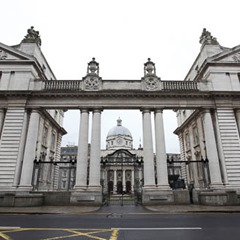Risks to the State
 The Government has earmarked future crises which could damage Ireland’s interests. eolas reviews its findings.
The Government has earmarked future crises which could damage Ireland’s interests. eolas reviews its findings.
Debt, climate change and disrupted energy supplies are among the greatest risks facing the State outlined in the draft National Risk Assessment. Published by the Department of the Taoiseach in April, the paper is open for consultation up to 30 June and a final version will be published in the autumn.
“Complacency at a time of prosperity” was one example highlighted by Enda Kenny. “Never again should dissenting voices be silenced when warning of risks up ahead.”
Ireland’s debt is its key economic risk, especially as the Fiscal Compact Treaty now demands that euro zone states make progress towards a balanced budget. EU intervention begins if a country significantly deviates from its target.
The State’s economic outlook “remains uncertain and dependent on external demand” and new turbulence in the euro zone will affect its credit rating. The banks remain vulnerable and fiscal harmonisation could deter inward investment (if it means higher corporation tax).
Climate change risks include higher average temperatures, more extreme weather conditions, more river and coastal flooding, water shortages, and disruption to species, including the possible extinction of the most vulnerable flora and fauna. Food scares can undermine the reputation of Irish agriculture.
Eighty-six per cent of Ireland’s energy supply is imported and that supply could be disrupted by either natural disasters or geopolitical change “as the recent crisis in Ukraine has highlighted.”
As a small neutral country, Ireland relies on international law and collective action within the EU as the best way to protect its interests. The banking union “suggests the need for stronger institutions at the centre” but further integration could also provoke a counter-reaction from some member states and their electorates.
The Government expects “profound uncertainty” if Britain votes to leave the EU in 2017 but it may also face “instability” in the North as soon as this autumn if Scotland votes for independence.
Ireland could be used as a “hub” for launching terrorist acts in continental Europe and this would cause lasting damage to its “safe and secure” image.
Cyber-attacks, pandemics and nuclear contamination (from elsewhere) are some of the technological risks which are likely to raise public fears. A quieter one is change itself i.e. what if technology advances too quickly and makes some Irish-made products obsolete?
100,000 people have been jobless for more than three years. Long-term unemployment is therefore a significant social risk, along with emigration and ageing. Ireland should be grateful for its social cohesion – when other countries have reacted violently to austerity – but this could be undermined if the gap between rich and poor grows.
Comments can be submitted to nra@taoiseach.gov.ie
A previous national risk assessment was drawn up by the Department of Defence in 2012 and focused on responding to emergencies. More analysis is available in the Defence Green Paper and the ministerial briefs published in 2011.





